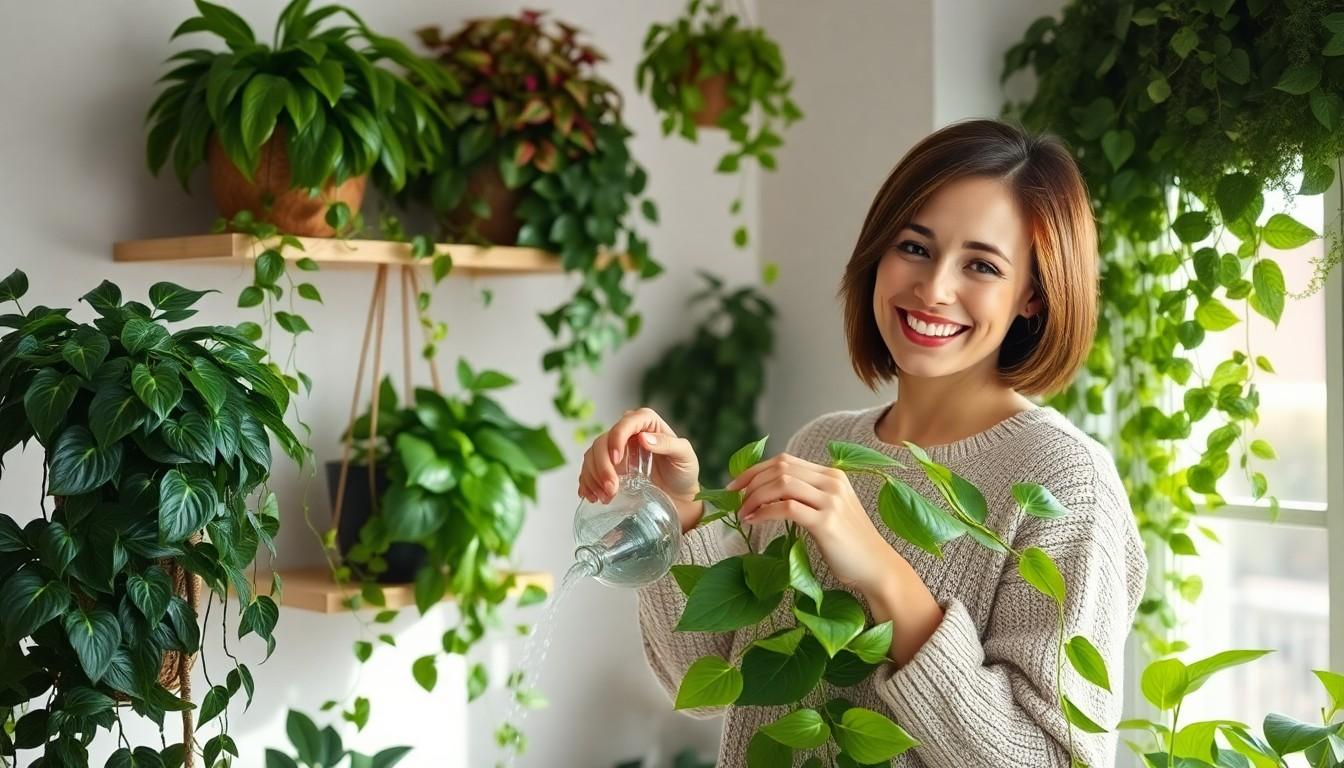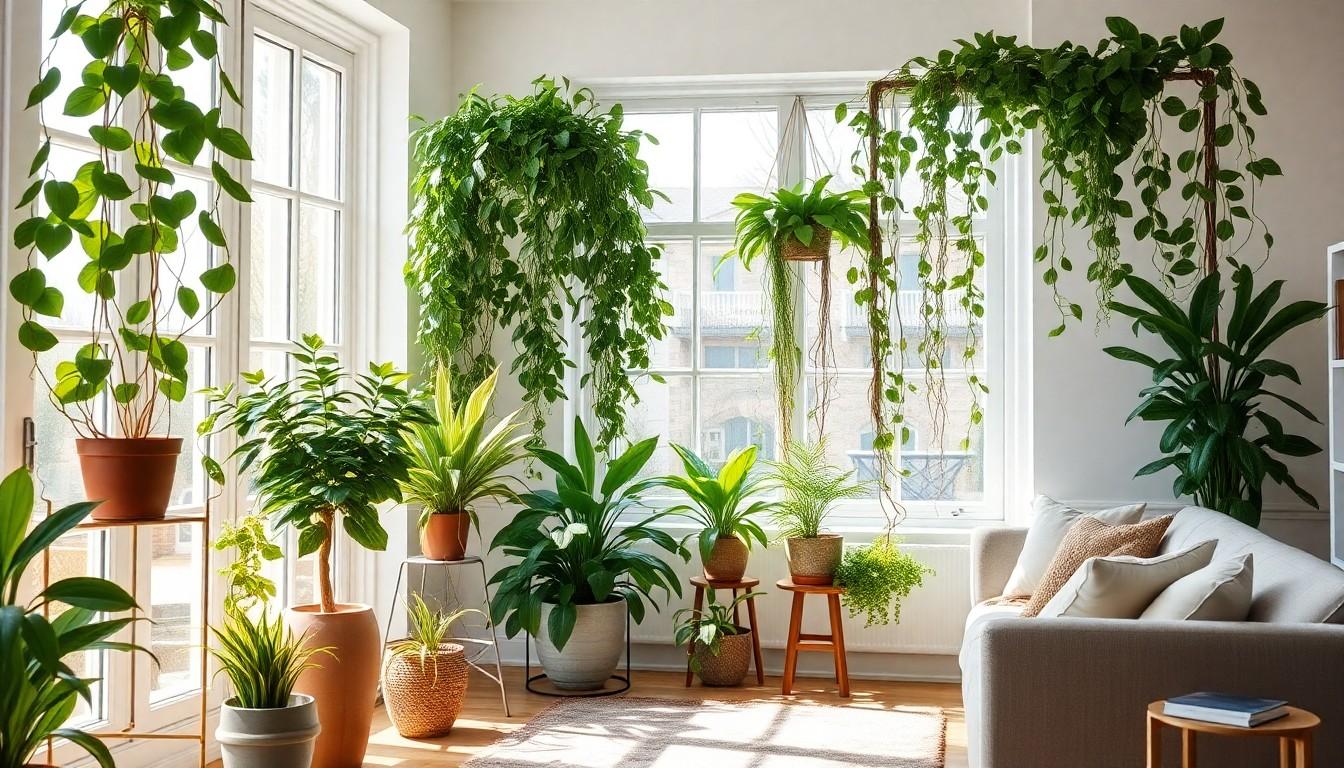Physical Address
304 North Cardinal St.
Dorchester Center, MA 02124

Indoor vine plants are the unsung heroes of home decor, especially when low light tries to steal the spotlight. Who needs a sun-soaked garden when you can bring the lushness of nature indoors? These leafy wonders thrive in the shadows, proving that even the most light-challenged corners can become vibrant green havens.
Imagine transforming that dimly lit room into a botanical paradise without needing a degree in plant whispering. With a little help from these resilient vines, even the most neglected spaces can flourish. Plus, they’re the perfect excuse to ignore your indoor lighting situation—after all, who needs bright lights when you’ve got a thriving plant party going on? Embrace the low light lifestyle and let these charming vines do the heavy lifting in your home.
Indoor vine plants thrive in low-light conditions, making them perfect for various indoor spaces. These plants offer both aesthetic appeal and air purification benefits. Their cascading growth patterns harmonize with walls, bookshelves, and windowsills, creating visual interest in any room.
Popular options include pothos, philodendron, and ivy. Pothos possesses heart-shaped leaves that adapt well to indirect sunlight. Philodendron showcases lush foliage, thriving with minimal care. Ivy, known for its climbing abilities, adds a charming touch to interior spaces.
Choosing the right vine can enhance the overall vibe of a room. Vines contribute to a calming atmosphere, promoting relaxation and improving mood. Indoor vine plants grow well in pots, hanging baskets, or even trained along trellises.
Maintaining these plants involves minimal effort. Regular watering, ensuring well-draining soil, and occasional pruning promote healthy growth. Many types of indoor vines flourish with just a few hours of indirect light daily, making them suitable for spaces with limited natural light.
These plants create a sense of connection to nature inside the home. Individuals who select indoor vine plants enjoy green accents that energize and uplift their surroundings. By incorporating these plants, homeowners can establish lively green corners without the hassle of extensive care routines.

Low light indoor plants offer numerous advantages for homeowners. These resilient vine plants serve as functional decor while enhancing interior environments.
Indoor vine plants like pothos and ivy effectively cleanse the air. They filter common toxins such as formaldehyde and benzene, contributing to better indoor air quality. A study by NASA identified several houseplants that can remove pollutants, highlighting their importance in urban living spaces. Breathing cleaner air promotes overall health, reducing allergens and improving well-being. With these plants, occupants enjoy fresher air without sacrificing style. Air purification becomes effortless, creating a healthier living atmosphere.
Aesthetic appeal thrives with low light indoor plants. Their lush greenery adds vibrancy to any space, transforming dull corners into lively areas. Pothos, for example, features heart-shaped leaves that cascade beautifully, enhancing visual interest. Philodendron showcases a variety of leaf shapes, making it a versatile choice for decor. Incorporating these vines can create a calming ambiance, promoting relaxation. Interior design is elevated as these plants blend seamlessly into various decor styles, from modern to traditional. Visual aesthetics and serenity coexist, encouraging homeowners to embrace the beauty of greenery indoors.
Indoor vine plants thrive in low light, offering both beauty and air purification. Here are some of the best options for enhancing dimly lit spaces.
Pothos stands out for its heart-shaped leaves that flourish in indirect sunlight. This resilient plant tolerates neglect and minimal watering, making it an excellent choice for busy individuals. Its vibrant green foliage can grow in various lengths, adapting to any space. Pothos also aids in air purification, effectively filtering out toxins like formaldehyde and benzene. Overall, its aesthetic appeal combined with easy care makes it a favorite for indoor environments.
Philodendron impresses with lush, vibrant foliage that can suit diverse interior styles. This plant prefers indirect sunlight and requires infrequent watering, making it easy to maintain. It offers various forms, including trailing and upright varieties, providing flexibility in decoration. Philodendron contributes to improved air quality by removing harmful pollutants, promoting a healthier indoor atmosphere. Its versatility allows it to thrive in various rooms, from living areas to bedrooms.
Creeping fig excels in low-light conditions, featuring small, heart-shaped leaves that create a lush green backdrop. This vine grows well on walls or shelves, providing a natural touch to any space. While it prefers regular watering, it can adapt to drier environments without severe issues. Creeping fig also enhances air quality, making it an excellent choice for health-conscious individuals. Its unique growth pattern adds character while enhancing overall aesthetics in a room.
Caring for low-light vine plants involves understanding their specific needs. Each aspect of plant care contributes to their health and growth.
Watering requires attention to the plant’s moisture level. Overwatering can lead to root rot, so it’s vital to check the soil before adding more water. Pothos, for example, thrives when given water once the top inch of soil feels dry. Ivy prefers slightly more moisture but also benefits from drying out between waterings. Adjusting the frequency based on season changes helps maintain balanced hydration. They’re more forgiving than other plants, making them suitable for busy lifestyles.
Soil choice impacts root health and nutrient availability. A well-draining potting mix supports the needs of these low-light vines. A mix containing peat moss, perlite, or coconut coir promotes aeration and moisture retention. Pothos adapts well to various soils but flourishes in a rich, slightly acidic mix. Philodendron excels in a loamy blend, enhancing its growth potential. Regularly refreshing the soil every year or two can promote overall plant vitality.
Light conditions influence vine health and growth patterns. Low light doesn’t mean no light; indirect light sources suffice for these plants. Positioning pothos near a window with filtered sunlight fosters a thriving environment. Ivy does well in similar conditions, thriving even in rooms without direct exposure. Philodendron adapts to different levels of light, thriving in dim areas while maintaining its lush foliage. Placement plays a significant role in ensuring these plants remain vibrant and healthy.
Indoor vine plants are a fantastic choice for those looking to enhance their living spaces without the need for bright light. Their ability to thrive in low-light conditions makes them perfect for apartments and homes with limited natural sunlight. With options like pothos, philodendron, and ivy, individuals can enjoy both aesthetic appeal and air purification benefits.
By selecting the right vine plants and following simple care tips, anyone can cultivate a lush indoor garden. These resilient plants not only beautify spaces but also contribute to a healthier home environment. Embracing low-light vines can truly transform any dull area into a vibrant oasis.